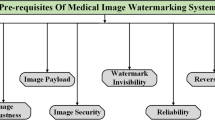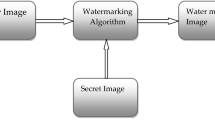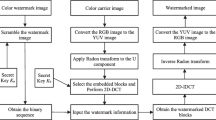Abstract
A novel algorithm that improves a generalized integer transform based reversible watermarking scheme is proposed in this paper. In our proposed algorithm, two main improvements have been achieved: adaptive thresholding and efficient location map encoding. With adaptive thresholding, suitable threshold \(t\) is selected adaptively, which ensures enough embedding capacity for the watermark while keeps the distortion introduced as low as possible. This modification is influential as an unsuitable threshold can lead to insufficient space for the watermark or even degrade the visual quality of the image. Moreover, efficient location map encoding helps in reducing the location map size, which down to 0.4 of the one unmodified in average. Therefore, more capacity is available for embedding as there is lesser overhead information. Overall, it provides more embedding capacity whereas improves the visual quality of the embedded image.










Similar content being viewed by others
References
Agrawal R, Srikant R (2000) Privacy-preserving data mining. SIGMOD Rec 29:439–450
Fridrich J et al (2001) Invertible authentication watermark for JPEG images. In: Proceedings of the international conference on information technology: coding and computing, 2001, pp 223–227
Fridrich J et al (2002) Lossless data embedding-new paradigm in digital watermarking. EURASIP J Appl Signal Process 2002:185–196
Kalker T, Willems FMJ (2002) Capacity bounds and constructions for reversible data-hiding. In: 14th international conference on digital signal processing, 2002. DSP 2002, vol 1, pp 71–76
Kamstra et al (2004) Wavelet techniques for reversible data embedding into images. Centrum voor Wiskunde en Informatica, Amsterdam, PAYS-BAS
Celik MU et al (2005) Lossless generalized-LSB data embedding. In: IEEE transactions on image processing, vol 14, pp 253–266
Kamstra L, Heijmans HJAM (2005) Reversible data embedding into images using wavelet techniques and sorting. In: IEEE transactions on image processing, vol 14, pp 2082–2090
Jun T (2003) Reversible data embedding using a difference expansion. In: IEEE transactions on circuits and systems for video technology, vol 13, pp 890–896
Alattar AM (2003) Reversible watermark using difference expansion of triplets. In: Proceedings of international conference on image processing, ICIP 2003, vol 1, pp I-501–504
Alattar AM (2004) Reversible watermark using the difference expansion of a generalized integer transform. In: IEEE transactions on image processing, vol 13, pp 1147–1156
Alattar AM (2004) Reversible watermark using difference expansion of quads. In: Proceedings of the IEEE international conference on acoustics, speech, and signal processing, 2004 (ICASSP ’04), vol 3, pp iii-377–380
Thodi DM, Rodriguez JJ (2007) Expansion embedding techniques for reversible watermarking. In: IEEE transactions on image processing, vol 16, pp 721–730
Shaowei W et al (2008) Reversible watermarking based on invariability and adjustment on pixel pairs. IEEE Signal Process Lett 15:721–724
Zhicheng N et al (2006) Reversible data hiding. In: IEEE transactions on circuits and systems for video technology, vol 16, pp 354–362
Xuan GS, Yao YQ, Ni Q, Yang Z, Gao J, Chai P (2006) Lossless data hiding using histogram shifting method based on integer wavelets. In: Presented at the LNCS. International workshop digital watermarking, Jeju Island, Korea
Fallahpour M, Sedaaghi MH (2007) High capacity lossless data hiding based on histogram modification. In: Presented at the IEICE electron express
Wei-Liang T et al (2009) Reversible data hiding based on histogram modification of pixel differences. In: IEEE transactions on circuits and systems for video technology, vol 19, pp 906–910
Lixin L et al (2010) Reversible image watermarking using interpolation technique. In: IEEE transactions on information forensics and security, vol 5, pp 187–193
Shi YQ et al (2004) Lossless data hiding: fundamentals, algorithms and applications. In: Proceedings of the 2004 international symposium on circuits and systems, 2004. ISCAS ’04, vol 2, pp II-33–36
Bin Z et al (2010) A near reversible image watermarking algorithm. In: International conference on machine learning and cybernetics (ICMLC), vol 2010, pp 2824–2828
Xiang W et al (2010) Efficient generalized integer transform for reversible watermarking. IEEE Signal Process Lett 17:567–570
Skretting K et al (1999) Improved Huffman coding using recursive splitting. In: NORSIG 1999. Proceedings of Norwegian signal processing symposium, Asker, Norway
Acknowledgments
The authors would like to thank the referees for their valuable comments. This research was supported in part by the Research Committee of the University of Macau and the Science and Technology Development Fund of Macau SAR (Project No. 034/2010/A2).
Author information
Authors and Affiliations
Corresponding author
Rights and permissions
About this article
Cite this article
Pun, CM., Choi, KC. Generalized integer transform based reversible watermarking algorithm using efficient location map encoding and adaptive thresholding. Computing 96, 951–973 (2014). https://doi.org/10.1007/s00607-013-0357-6
Received:
Accepted:
Published:
Issue Date:
DOI: https://doi.org/10.1007/s00607-013-0357-6




